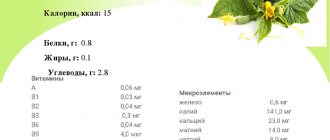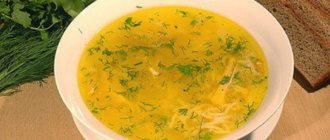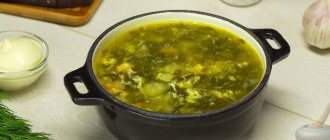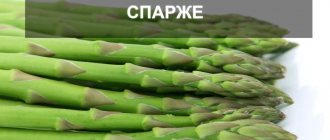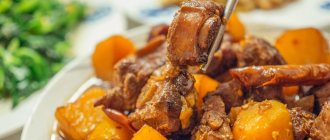Rice is one of the oldest crops that people grow for food. Today we can no longer imagine our diet without this product, although it came to Russia only in the 19th century. Considering all the beneficial qualities of rice and its nutritional value, humanity simply could not leave this culture unnoticed. Currently, we can enjoy several types of this product. Boiled rice, whose calorie content is of interest to many, is the basis of many dishes. Let's consider its qualities and beneficial properties.
A little history
The origins of people's acquaintance with this culture must be sought in the Ancient Chinese Empire. It was there that rice became most widespread. It was used for more than just food. He was an obligatory participant in rituals and ceremonial events. Ancient manuscripts testify to this. Gradually, with the development of trade relations, rice grains entered the countries neighboring China: India, Thailand, Japan and Vietnam.
It is in these regions that rice still remains one of the main products. The Asian climate is ideal for growing this crop. Over time, rice became known in all corners of the planet, and it firmly took its place among the most important, versatile, tasty and nutritious foods.
Fried rice with onions and carrots in a frying pan
For some reason, fried rice is cooked less often than stewed rice. But in vain, in fact, the dish will turn out to be very original and tasty. Boiled rice goes well with vegetable pasta - most importantly, don’t be afraid to cook new dishes.
Cooking time: 40 minutes. 100 g serving of rice: 255 kcal.
How to cook delicious:
- Take regular short grain rice and rinse in three waters. Place it in a saucepan and fill it with clean water at room temperature in a 1:1 ratio. If you are afraid that the water will boil away, you can add a little. Pour a little refined oil into the pan and put on maximum heat;
- When the water boils, immediately reduce the heat to low and cover the pan with a lid or foil. Simmer rice for 20 minutes;
- Grind the onion, garlic, coriander, chili and carrots in a blender to a paste;
- Heat 35 ml refined oil in a heavy frying pan. Add pasta and cook over medium heat for 2 minutes;
- Pour the remaining oil into the frying pan, add the cooked and now cooled rice;
- Fry the rice until it is hot, then add the chopped green onions and cook for another minute.
Types of rice
Today on store shelves you can find different varieties of this cereal. Boiled white rice, the calorie content of which we will consider below, is no longer the only representative of this family. This cereal is classified depending on color, grain size, processing method and even smell. There are long-grain, medium-grain and short-grain rice. According to the processing method, white, brown and golden, steamed grains are divided. Basmati rice grown in Pakistan or India is considered the best and most expensive. Its grains reach a length of up to 10 millimeters when raw, and up to two centimeters when cooked.
Application
The most common use of boiled white rice is as a side dish for meat or fish dishes. It goes equally well with sweet dried fruits and with mushrooms or pickles. It is added to stuffed vegetables or poultry and fried with vegetable mixtures. The now popular sushi and Japanese rolls are made from white boiled rice. Cooking rice is a process that requires attention. Before cooking, the rice is washed, preferably in several waters. Cook over medium heat, in a thick-walled container, this helps avoid burning. Short grain rice is better suited for making porridges due to its viscosity and stickiness. Long grain, on the contrary, remains crumbly after cooking.
Market Analytics
- Black Lives Matter movement: reaction and consequences for the beauty industry
- COVID-19 is changing the rules of the game in the cosmetics market
- Beauty of the future: cosmetic innovations 2021
Convenient search for beauty salons on our website
Beauty salons in Moscow Beauty salons in St. Petersburg Beauty salons in Ekaterinburg Beauty salons in Novosibirsk
Latest blog posts on our website
- Naturecream / Tremella Extract - Snow Mushroom Detox for Skin
- Prostye-sovety / How to visually enlarge your lips with makeup
- Naturecream / Apricot kernel oil for face
- Naturecream / MATRIXYL3000 - the best skin elasticity stimulator
- Naturecream / SPF in Natural Oils
- Naturecream / Geranium (Pelargonium) oil for skin health and beauty
- Prostye-sovety / Save on a beauty salon: procedures that can be done at home
- Naturecream / Growth Factor - brings back youth?
- Oksana-Lezina / 3 effective abdominal exercises from a fitness instructor for beginners
- Prostye-sovety / Making perfect curls at home
Latest forum topics on our website
- Natalya / How to properly make a gelatin mask?
- Mrs._Smith / Badly sunburned! What to do?((
- Ice / Is it necessary to combine fitness classes with a diet?
- Antonova / What can be used for hair loss?
- Radio operatorKat / Who was on a protein diet?
Other articles in this section
| Buckwheat flakes Buckwheat flakes are a derivative of whole buckwheat grains. The process of making such flakes is very gentle. Buckwheat grains are cut using special equipment and pressed into thin plates. Such production makes it possible to preserve as much as possible all the beneficial properties of the cereal, making buckwheat flakes a nutritious, but at the same time dietary product. |
| Polished rice Polished rice is distinguished by the white color of the grains, while the upper hard layer and the brown layer of bran are completely removed. Rice is one of the oldest agricultural crops. The domestication of rice occurred about 9 thousand years ago, in countries with a warm, humid climate. In Japan, India and China, rice is treated very carefully - it is considered the main food of the population. Rice is very capricious, so where the temperature can drop below 10°C, it is not possible to grow rice. |
| Semolina porridge with milk Semolina porridge is finely ground wheat, and now several types of semolina porridge are known, which differ depending on what kind of wheat was used: hard, soft or mixed varieties. Semolina began to be prepared in Rus' back in the time of the princes, but semolina porridge was not popular for a very long time. The reason was that it was expensive to obtain, which is why only very wealthy people could afford it. Semolina porridge gained true popularity already in the USSR. |
| White rice White rice is a widespread cereal crop of the cereal family. Thailand and Vietnam are considered to be the birthplace of rice, where it is a national food product. Today it is grown in many countries around the world, mainly in tropical and subtropical climates. The word “rice” itself appeared in Russia around the end of the 19th century. White rice goes through all stages of polishing, so it is white, but can also be translucent. It is divided into long-grain, medium-grain and round-grain. |
| Pearl barley porridge on water The “name” of this porridge comes from the English word pearl. Barley grains, after removing the top layer from them and polishing, are very reminiscent of pearls. After all, it is by grinding barley that pearl barley is obtained. Peter I especially appreciated the beneficial properties of this dish, even considering pearl barley to be the “queen of porridges.” |
| Pearl barley Pearl barley is the core of barley grain. At the very first stage, it undergoes heat treatment and cleaning from small husks. During processing, pearl barley is ground about six times and undergoes a polishing process using special polishing systems, which makes the grain very smooth. Also, the process of processing pearl barley includes crushing. To remove residual barley flower films from fruit and seed coats, the grain is passed through magnetic devices. At the final stage of processing, automatic sorting occurs according to the size of the resulting grain. |
| Oatmeal Oatmeal is flour made from oat or barley grains, initially steamed, dried, fried, peeled and crushed. Oatmeal, unlike ground flour, is endowed with a wonderful taste, very nutritious due to the preservation of all grain parts, and in ground flour the most nutritious fractions often go to waste. Since oatmeal retains all the elements of the original plants, oatmeal flour is ready for consumption without any processing. Previously, oatmeal was prepared from oats kept overnight in a warm oven. The grain proteins changed, and the flour from these grains lost the ability to form gluten, but at the same time had the opportunity to swell in water and become thick. |
| Soft wheat grains Wheat is one of the most popular agricultural crops in the world. This culture has always played a special, sacred role in the life of the Slavic peoples. They started growing it a very long time ago. According to archaeologists, the first wheat plantations appeared 9 thousand years ago in areas of Asia and Egypt. |
| Barley porridge with milk Barley porridge was first mentioned in the Stone Age, in Egypt and Syria. Today, this cereal grows both in Africa and in the mountains of Tibet. |
| Cooked couscous A product called couscous is a kind of Moroccan-style pasta. This product has been known from real written sources since the 18th century, when this porridge was very common in the Maghreb countries. Translated from the Berber language, this word means “well rolled.” Couscous is very popular in Morocco, Libya, Tunisia, as well as in Israel and Italy. In fact, this is a special cereal that is increasingly gaining popularity among housewives. |
Useful properties of rice
Boiled rice, whose calorie content is not so high, has an excellent composition. It is not without reason that it is consumed in large quantities by residents of Asian countries, most of whom are long-livers. Rice contains many elements of the periodic table that are so necessary for the body. These are potassium, sodium, magnesium, calcium, copper, zinc, phosphorus, sulfur and iron. Eating rice strengthens the immune and nervous system.
This cereal also contains a large amount of vitamins: E, K, riboflavin, niacin, pyridoxine, thiamine, pantothenic and folic acid. Therefore, rice grains have a positive effect on the condition of the skin, hair and nails. The maximum amount of nutrients and fiber is found in brown rice. 50 grams of rice (raw) contains the daily requirement of protein. Grains are also rich in complex carbohydrates, which provide the body with energy for a very long time. But since we eat boiled rice, its calorie content is significantly reduced. That is why this product is recommended for dietary nutrition.
The benefits and harms of rice
Rice perfectly energizes and provides a long-lasting resource for the functioning of all systems of the human body. A high percentage of vitamins B and PP has a positive effect on digestion, hair and nails. But these are not all the positive properties of cereals:
- Rice water can coat the walls of the stomach and intestines with a protective film, which makes it an excellent assistant in the fight against stomach and duodenal ulcers.
- The high fiber content in cereals helps normalize intestinal microflora, reducing the risk of developing diabetes.
- The low calorie content of boiled rice without additives allows you to safely include it in the diet of those people who closely monitor their weight.
- Removes toxic substances from the body during intoxication.
- Rice grains do not contain salts, so they can be eaten by people with kidney and gallbladder diseases.
- It contains a large amount of insoluble dietary fiber, which acts as a brush in the body, expelling all decay products, and also preventing the occurrence of cancer cells.
- The cereal contains a small amount of sodium, so people with hypertension can safely use it as food.
- Rice, especially brown rice, contains a high percentage of neurotransmitters that normalize brain function and prevent the development of Alzheimer's and Parkinson's diseases.
- Antioxidants contained in cereals reduce cholesterol levels and stabilize the functioning of the nervous system.
- The product is rich in complex carbohydrates, so it perfectly fights the feeling of hunger, while leaving you feeling full for a long time.
- It has a mild diuretic effect and helps remove excess fluid from the body. The urinary and diaphoretic effect of rice broth is also useful in the treatment of pneumonia, influenza and sore throat.
- Important substances in the product are tryptophan and lecithin. They accelerate metabolic processes in cells, rejuvenate and heal the human body.
- Rice water helps remove phlegm, so it is recommended to drink for bronchitis and bronchial asthma.
Separately, it is worth noting the additional advantages of eating dishes prepared on the basis of rice cereals:
- reduces stomach acidity;
- improves digestion;
- regulates metabolism;
- cleanses the cardiovascular system and the body as a whole;
- regulates the functioning of the thyroid gland and endocrine system.
Despite the significant list of positive properties, some nutritionists and ordinary people classify rice as harmful foods. About 20 years ago, health workers noticed that China had a high incidence of stomach cancer. This fact was immediately associated with the large volume of rice grain consumed by the Chinese and classified it as a product hazardous to health.
Interesting! Rice is considered a hypoallergenic grain and is recommended as one of the first foods for introducing complementary foods to babies. For example, it is recommended to give oat and wheat cereals to children much later.
In the absence of individual intolerance, which is extremely rare, rice cereal is an absolutely safe and edible product for any person. However, here, as elsewhere, moderation is important. The fact is that cereal contains a lot of starch, which can cause decreased intestinal motility and constipation.
Consumption rate
Important! When choosing a diet, it is worth considering the genetic factor. If your ancestors did not eat rice in large quantities, then you should not base your entire diet solely on this product. It will be enough to eat it 3-4 times a week.
According to Order of the Ministry of Health of the Russian Federation No. 614 dated August 19, 2016 “On approval of recommendations for rational standards of food consumption that meet modern requirements for a healthy diet,” the rate of rice consumption per year per person is 7 kg.
Based on this information, it is easy to calculate that government nutritionists recommend eating 19 grams of rice per day. This measure is too inconvenient, since it is unlikely that anyone will cook in such small portions.
If we translate complex arithmetic into simple everyday language, then the recommendations of the Ministry of Health can be reduced to a simpler formulation. A person, without harm to his health, can consume 1 serving of rice cereal of 150 grams once a week, and in addition to this, add cereal to dishes where it is not the main ingredient, for example, stuffed peppers with meat and rice, hedgehogs, and so on .
Parboiled, long grain rice
The calorie content of rice boiled in water depends on its variety. Long steamed grains of this cereal are often used to prepare pilaf and side dishes. This rice is steamed and has a length of no more than 8 millimeters. Why is such processing important? Thanks to it, 80% of the nutrients penetrate into the grain. This type of cereal does not stick together when cooked.
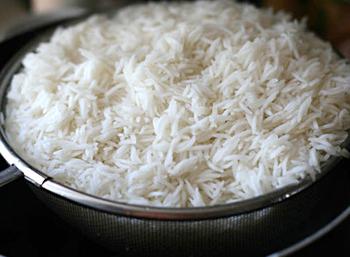
Steamed and boiled rice, which has very low calorie content, is excellent for dietary nutrition. It has a high ability to absorb moisture and removes salts and toxins from the body well. 100 grams of steamed product contains 79 grams of carbohydrates, 6.5 grams of proteins and 1 gram of fat. Boiled rice, the calorie content of which is about 170 kcal per 100 grams, has a glycemic index of 60 GL.
Rice based diets
Rice-based diets are divided into soft and hard . It is recommended to go on a strict rice diet rarely and only in case of urgent need (and better yet, never).
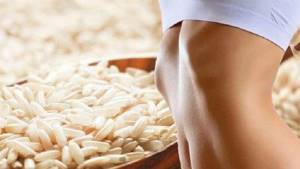
Strict diets most often last 3 days and involve the consumption of boiled cereals (1 glass of dry cereal per day) without adding salt, pepper, other spices and additives. This diet can be diluted with natural juices.
There are options for extending this diet . For example, for 3 days they eat exclusively rice, on the 4th day they allow themselves fruit or chicken breast, then again they return only to cereals.
Milder diet options are rice, vegetables, chicken or rice, vegetables, fruits, chicken. Such diets most often last no more than ten days. The daily diet looks something like this:
- breakfast – rice with water (do not add salt);
- lunch – boiled rice with chicken breast;
- afternoon snack - orange;
- dinner - boiled cereal without salt.
The diet may vary depending on the specific diet and day of the week.
A nine-day diet is also popular , when the first three days they eat cereal, the next three days - chicken in its various variations, and the last three days - vegetables and fruits in any form.
Important! There are many variations of diets with rice as the main ingredient. One thing remains unchanged: any strict diet is stressful for the body, so you should create a menu wisely, and it is better to consult with a specialist before doing so.
White rice with round grains
This variety is distinguished by its small grain size (no more than 5 millimeters), smooth structure and perfectly white color. It is great for making porridges. This rice is valued in Italy and Japan for its high adhesive properties. This product also contains quite a lot of useful substances.

However, the caloric content is also not the lowest. 100 grams of product contain 79 grams of carbohydrates, 0.52 grams of fat and 6.5 grams of proteins. Boiled rice, whose calorie content is 179 kcal, has a glycemic index of 70 GL.
Rice dishes
The composition of the dishes no longer includes one or a couple of ingredients, so calculating the calorie content of such dishes is more difficult.
| Type of dish | Calorie content, kcal |
| Pilaf | 207 |
| Cabbage rolls with rice | 149 |
| Soup with rice | 54 |
| Cabbage rolls with minced meat and rice | 133 |
| Stuffed pepper | 149 |
| Hedgehogs with rice | 165 |
| Meatballs with rice | 158 |
| Crab salad with rice | 194 |
| Chicken soup with rice | 63 |
| Product type | Calorie content, kcal |
| Boiled | |
| Rice | 116 |
| Buckwheat | 114 |
| Potato | 83 |
| Fried | |
| Rice | 188 |
| Buckwheat | 108 |
| Potato | 188 |
| Stewed | |
| Rice | 158 |
| Buckwheat | 132 |
| Potato | 105 |
Rice groats have the highest calorie content, and buckwheat groats have the lowest. Potatoes occupy the middle ground, but they are high in starch. Having set yourself the goal of losing excess weight, you should give preference to buckwheat. Conversely, having decided to make up for the lack of mass, you should eat more rice dishes.
The nutritional value
The calorie content of a product does not provide comprehensive information about its nutritional value. To calculate it, the content of proteins, fats, carbohydrates and other substances in the product must be taken into account. Only by knowing and analyzing all these indicators can you get a clear picture of the usefulness of the product and the need to include it in your diet.
| 100 grams of dry white rice contains: | |
| Squirrels | 7.5 g |
| Fats | 2.6 g |
| Carbohydrates | 62.3 g |
| Alimentary fiber | 9.7 g |
| Water | 14 g |
The need to include rice in the human diet is due to the high content of vitamins and microelements, such as:
- Vitamins: B1, B2, B5, B6, B9, E, H, PP;
- Minerals: K, Ca, Mg, Na, Ph, Cl;
- Microelements: Si, Fe, I, Co, Mn, Cu, Mo, Se, F, Cr, Zn.
Rice is especially noteworthy for its high content of silicon (4133% of daily intake in 100 grams), manganese (182% of daily intake in 100 grams), cobalt and copper (about 50% of daily intake in 100 grams).
Jasmine, blue rice
It is impossible to grow cereals of this color. But in Thailand, jasmine rice is colored with the flowers of the Clitoria ternatea plant. This culture is also a soothing tea. It is this that gives rice grains such a delicate, violet-blue color. This grain is used to prepare various dishes in the same way as ordinary rice. Giving it a specific color does not affect its taste in any way, and it also has a subtle jasmine flavor. Boiled rice, the calorie content of which is 170 kcal per 100 grams, contains 79 grams of carbohydrates, 6.7 grams of proteins and 0.7 grams of fat. Its glycemic index is 60 GL.
How to choose rice
The taste and benefits of cereals directly depend on the degree of freshness and purification stages that the original grain goes through. In order to choose a good product, it is recommended to first pay attention to the following aspects:
- integrity of the packaging, availability of information about the date of manufacture and manufacturer, as well as a GOST type quality certificate;
- the presence of impurities (larvae, sand, dry grass, grains of other colors and sizes) - all this indicates poor processing of the raw materials;
- shelf life. All varieties of cereals, except basmati, must be as fresh as possible; only basmati can be stored for up to one and a half years, and its taste and aroma will become more intense over time.
You need to buy a product based on your own experience. It is better to purchase brands that have already been tried and liked. When purchasing any new product, it is better to first prepare a small portion to try, and if you like it, then cook for the whole family.
Brown, unpolished rice
As mentioned above, this variety of rice is considered the healthiest. The shell that remains on the grains contains a large amount of nutrients and fiber. That's why this product is preferred by those who are on a diet or watching their diet. The color of rice is due to the presence of a valuable shell on top.
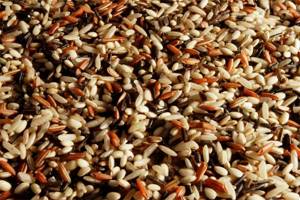
It is usually brown, brown or dirty gray in color. This rice normalizes digestion, removes toxins from the body and lowers cholesterol levels. The calorie content of boiled brown rice is about 167 kcal, and the glycemic index is only 50 GL. 100 grams of this product contains 1.8 grams of fat, 7.4 grams of protein and 73 grams of carbohydrates.
Rice calorie table by variety
So how many calories are in rice? In fact, it is impossible to name one specific figure, since the indicators vary quite a bit depending on the type of cereal. By the way, for this reason, the BJU of rice also varies.
As you can see from the table, the usual white round-grain and steamed varieties have the most calories. Wild rice is also high in calories—357 kcal per 100 grams. For the long-grain white variety, this figure is 365 units, as is the case for the jasmine variety, and for the steamed long-grain variety it is 341. The calorie content of the sushi variety is 350 kcal, basmati - 342 units. But puffed rice is a real leader (it has 402 kcal).
The healthiest thing for your figure is black rice, which contains minimal calories and carbohydrates, which are the first enemy of slimness. You can also add red and brown rice to your diet menu.
Sometimes bulgur is mistakenly classified as a variety of rice. This is a completely different cereal, and its calorie content when cooked is only 83 kcal.
Black, wild rice
This variety of rice is divided into two types: thick grain and thin grain. The cooking method depends on this indicator. Rice with thick grains is highly dense. Before cooking, it must be soaked in water for several hours. After this, it is boiled for about one hour. Rice with thin grains cooks much faster. It does not require pre-soaking and cooks for about 20 minutes. This variety is usually used in combination with steamed, golden grains. This rice mixture is incredibly delicious.
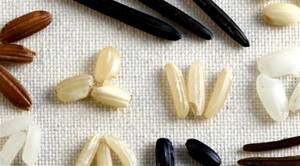
Black, wild rice gives the side dish a slightly sweet taste and a subtle aroma of nuts. Naturally, a dish prepared using wild rice will sparkle with new colors and flavor notes. This type of rice is very healthy. Among dietary varieties of cereals, it ranks first. The calorie content of rice boiled in water is only about 50 kcal. Naturally, its glycemic index is very small, only 35 GL. 100 grams of this product contains 0.4 grams of fat, 4 grams of protein and 21.5 grams of carbohydrates. All indicators are quite low.
conclusions
You should definitely include it in your diet at least once a week, especially since it is recommended by the Russian Ministry of Health. A variety of cooking options: rice with onions and butter, with meat (chicken, beef or pork), pies with rice, lazy cabbage rolls - will make each dish made from this cereal unique and special. The low calorie content of the product allows those on a diet to eat it without fear.
An additional advantage of cereal is that there are many varieties of it, brought from different parts of the world, so it will not be difficult for every resident of the CIS to choose rice to suit their taste and budget.
Pink rice
The large number of varieties of this crop is striking in its diversity. Devzira is a type of cereal with a pleasant pink tint. This rice can be either unpolished or lightly polished. Its distinctive feature is its high nutritional value and significant protein content. Pink rice has the ability to absorb moisture well. Therefore, during the cooking process, its grains increase 8 times. Despite this, the cereal does not lose its shape and does not stick together. The finished grains have a very pleasant aroma and delicate taste. It is a good source of minerals and antioxidants. The calorie content of the raw product is 311 kcal. 100 grams of rice contains 70 grams of carbohydrates, 6.2 grams of protein and 0.7 grams of fat. The glycemic index of pink rice is 60 GL.
Boiled rice. Low calorie content - big benefits
Rice with carrots and onions
rich in vitamins and minerals such as: vitamin A - 42.2%, beta-carotene - 45.6%, silicon - 71.7%, cobalt - 20.5%, manganese - 14.9%
- Vitamin A
is responsible for normal development, reproductive function, skin and eye health, and maintaining immunity. - B-carotene
is provitamin A and has antioxidant properties. 6 mcg of beta carotene is equivalent to 1 mcg of vitamin A. - Silicon
is included as a structural component in glycosaminoglycans and stimulates collagen synthesis. - Cobalt
is part of vitamin B12. Activates enzymes of fatty acid metabolism and folic acid metabolism. - Manganese
is involved in the formation of bone and connective tissue, and is part of enzymes involved in the metabolism of amino acids, carbohydrates, and catecholamines; necessary for the synthesis of cholesterol and nucleotides. Insufficient consumption is accompanied by slower growth, disturbances in the reproductive system, increased fragility of bone tissue, and disturbances in carbohydrate and lipid metabolism.
more hide You can see the complete directory of the most useful products in the application
The porridge is rich in vitamins B, H, E, PP, manganese, potassium, zinc, magnesium, copper, selenium and many other minerals.
The calorie content of rice boiled in water is 116.3 kcal. 100 g of dish contains:
- 2.22 g protein;
- 0.6 g fat;
- 24.7 g carbohydrates.
Due to the high content of natural fiber, the product helps to quickly cleanse the intestines of toxins. Regular consumption of boiled rice is useful for the prevention of diseases of the liver, kidneys, heart, and blood vessels.
Boiled in water
Brown rice absorbs less moisture during cooking than white rice. The variety is quite harsh, so many people refuse to use it. Cereal cooked without additives in water promotes weight loss and cleanses the intestines. Algorithm for preparing rice as an independent dish:
- pour 250 ml of cold water into a saucepan with a thick bottom;
- pour washed rice into it;
- cover with a lid and bring to a boil;
- reduce heat and cook the cereal for 35-40 minutes.
To maintain the structure of the grains, there is no need to stir the rice during cooking. The finished cereal turns out crumbly and retains a light nut aroma. Boiled cereal cannot be stored for a long time: it loses its taste 48-72 hours after heat treatment.
After washing it first, pour it into cool water and leave for 3-4 hours. This will reduce the cooking time by almost 2 times. Despite its low calorie content, you should not eat brown rice every day: it has an intense effect on the walls of the intestines and stomach.
We invite you to familiarize yourself with sea buckthorn oil at home
With salt
Despite various additives (salt, vegetable oils, spices), the calorie content of boiled brown rice remains unchanged (no more than 112 kcal). During the cooking process, the cereal retains all its beneficial properties. The composition remains virtually unchanged. BJU ratio:
- carbohydrates - 25 g;
- proteins - 3 g;
- fats - 1 g.
You can add salt to the water regardless of the stage of cooking. To prevent the grains from sticking together, you can add a little vegetable oil (olive, sunflower) to the rice.
Red rice
This variety grows in Thailand. Its distinctive feature is its expressive nutty taste and unusual aftertaste. The benefits of using such a product are very great. Rice contains a lot of antioxidants. Its consumption has a good effect on heart function and reduces cholesterol levels.

High fiber content helps speed up metabolic processes. The calorie content of raw red rice is 308 kcal and the glycemic index is 55 GL. This variety is high in fat (2.5 grams), 7 grams of protein, and 64.4 grams of carbohydrates.
How to cook rice with carrots, onions and tomatoes
Most often, carrots and onions are added to rice. But you can make it even tastier by adding tomatoes. Just first scald them with boiling water, peel them and chop them into cubes.
- 200 g long grain rice (or 2 packets);
- onions – 2 heads;
- refined oil – 50 ml;
- medium carrots – 2 pcs;
- firm tomatoes – 150 g;
- fresh or dried dill;
- salt – 12 g;
- freshly ground black pepper – 3 g.
Time required: 25 min. One serving 100 g: 250 kcal.
- If the rice is loose: rinse thoroughly, then fill it with clean water and cook for 20 minutes. To make the side dish crumbly, water should be taken in the following proportion: 1 part cereal + 1 part liquid;
- If the rice is in bags, then everything is much simpler. Boil it in salted water directly in the bags;
- Heat the oil in a heavy, deep frying pan and brown the finely chopped onion. Add coarsely grated carrots, simmer for a couple of minutes;
- Scald the tomatoes with boiling water and remove the skins. Peeled tomatoes can be cut into small cubes or pureed. Then add to the vegetables in the frying pan, stir and simmer for 5 minutes;
- Mix the dressing with the prepared rice, season with spices, pepper and, if necessary, salt.
How many calories are in buckwheat? All the beneficial properties of buckwheat
Buckwheat porridge and other buckwheat dishes are good for our health and well-being due to their balanced composition and high nutritional value. At the same time, you should not think that the nutritional value of buckwheat porridge is a consequence of its high calorie content. Not at all - the secret of nutrition lies in the large amount of “slow” carbohydrates and complete, easily digestible proteins in its composition.
In no case should you be afraid of the relatively large amount of carbohydrates in raw cereals. As we mentioned above, buckwheat does not contain any fast carbohydrates, which lead to sharp fluctuations in blood sugar levels. All carbohydrates contained in buckwheat are slow, which means that one serving of buckwheat porridge will create a long-term feeling of fullness, despite its low energy value. Thanks to this, buckwheat porridge is excellent for weight loss and can be included in a healthy breakfast, which will help avoid feeling hungry until lunch.
The most valuable nutritional components of buckwheat for people actively involved in sports, and, first of all, weightlifting, are proteins. Here they contain as much as 12.6 grams per serving. At the same time, the amino acid composition of proteins is one of the richest and most balanced among plant foods. Buckwheat proteins contain a large amount of important amino acids - lysine and methionine. At the same time, buckwheat proteins are highly digestible, which makes this grain indispensable in the diet of athletes to speed up muscle recovery after training.
Buckwheat does not contain a single gram of fast carbohydrates, which are responsible for the appearance of excess weight if consumed excessively.
Very often, buckwheat is used as a temporary substitute for meat and other sources of animal proteins. For the same reason, this cereal enjoys stable popularity among vegetarians, for whom its rich amino acid profile is especially important.
As for fats, there is very little of them in buckwheat - only 3.3 grams per serving. At the same time, there are no harmful saturated fats at all. However, it’s not for nothing that the proverb says that “You can’t spoil porridge with butter.” For better absorption and a more pleasant taste of buckwheat porridge, it is better to add a small amount of vegetable oil to it (linseed oil will be especially useful due to the high amount of OMEGA-3 and will perfectly complement the taste) or initially prepare it with milk rather than water. You can fry a portion of porridge with two eggs a little more, so it will become even more tasty and crumbly.
Useful material
For example, foods rich in potassium, which includes rice, are recommended for consumption by people with severe cardiovascular pathology.
Along with phosphorus and potassium, rice also contains other minerals that are extremely necessary for the body, such as:
- magnesium - 116 mg;
- silicon - 1240 mg;
- calcium - 40 mg;
- manganese - 3.63 mg;
- zinc - 1.8 mg;
- sulfur - 60 mg;
- sodium - 30 mg;
- iron - 2.1 mg.
Rice is a very valuable source of vitamins, amino acids and microelements so necessary for our body. It has enveloping properties and is indispensable for a number of gastrointestinal problems.
Low-calorie boiled rice is a product rich in starch, containing a number of vital amino acids and a large amount of dietary fiber. Due to its composition and low calorie content, rice perfectly regulates the activity of the entire digestive system.
Rice is known to be very beneficial for people with cardiovascular diseases. It is also recommended to be used in the diet of patients with diseases of the kidneys, blood vessels, and joints. This medicinal property is explained by the absence of salt in rice and the presence of sodium and potassium. At the same time, the lack of fiber in cereals can be compensated for by vegetables, which can be combined with boiled rice.
The low calorie content of boiled rice, as well as its other beneficial properties, are explained by its composition. It contains 7-8% protein, which contains 8 essential amino acids. They influence the correct process of formation of new cells in the body.
Rice does not contain gluten. Therefore, it is recommended for allergy sufferers. In addition to protein, the cereal contains B vitamins (vitamin B1 - 0.08 mg, vitamin B2 - 0.04 mg, vitamin B3 - 0.45 mg, vitamin B6 - 0.2 mg, vitamin B9 - 1.9 mg ), vitamin E – 0.4 mg, vitamin H – 3.5 mg, vitamin PP – 1.6 mg.
Along with the low calorie content of boiled rice, the presence of microelements such as zinc, boron, manganese, copper, nickel, molybdenum, fluorine, cobalt and chromium is also noted. Rice also contains up to 100 mg of potassium, 8 mg of calcium, and 50 mg of magnesium.
In addition, the cereal culture includes sodium (12 mg), iron (1 mg), sulfur (46 mg), phosphorus (150 mg). As well as chlorine (25 mg), silicon (100 mg) and other minerals. Rice contains lecithin. It is useful for people who are engaged in intellectual activities.
Cereal consumption standards
During the day, taking into account the calorie content of rice, an adult can eat from 250 to 500 grams of this product .
However, in Asian countries this figure may be twice as high. But children can eat up to 150 grams of the product per day, like other grain products. If you are a follower of proper nutrition and a healthy lifestyle, rice should be present in your diet, if not every day, then quite often. There are a huge number of healthy, tasty dishes based on it, and they can be simple, complex and delicious.
If we talk about diets or baby food, the most common dishes are:
- soup based on boiled rice with vegetables;
- rice casserole with low-fat cottage cheese;
- salad with boiled grains, lean meat and herbs;
- boiled rice in a slow cooker with zucchini, mushrooms and other vegetables;
- baked rice with chicken.
As you can see, this product has universal culinary uses; it is great for those who are accustomed to a healthy lifestyle and regularly count calories. No wonder many Asians consider it a key product in their diet.
Rice for weight loss
If you want to lose excess weight, cleanse your body of waste and toxins without cutting back on food, and without starving, rice will be a real godsend for you.
Rice is recommended by all world famous nutritionists as a product ideal for people who want to lose weight or are simply watching their figure.
By eating mainly rice dishes, you will not lose your energy, efficiency, and cheerfulness, since rice is a storehouse of carbohydrates and therefore a very valuable and sought-after element of healthy, tasty and healthy food.
Brown rice is very valuable, helping to effectively accelerate natural metabolism.
By including rice dishes in your diet and following certain rules, you can get rid of extra pounds without exposing yourself to unnecessary stress. At the same time, your body will be completely cleansed of unnecessary toxins, and your metabolism will increase significantly. All this together contributes to the rapid burning of calories and achieving the desired effect for weight loss.
Boiled rice: composition
Properly cooked white rice retains most of its beneficial properties. Chemical composition of boiled rice: sodium, phosphorus, iodine, iron, zinc, calcium, potassium.
This product is also rich in vitamins, which are represented by the following list: vitamin PP, H, E, D, B6, B5, B2, B1.
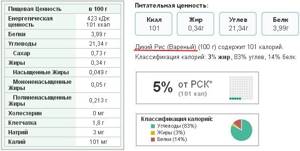
Boiled
The calorie content of 100 g of raw and 100 g of cooked rice differs significantly due to the fact that during cooking the grains absorb water. Accordingly, the mass increases. Thus, 100 g of boiled white rice without additives contains only 116 calories, 100 g of boiled brown rice has a calorie content of 110 calories, 100 g of boiled unpolished rice contains 125 calories, and 100 g of boiled wild rice contains only 78 calories. As a rule, salt, butter, raisins are added to rice or boiled in milk. To calculate the calorie content of supplements, consider the amount of ingredients. If this concerns milk, pay attention to its fat content. Salt will not add calories, since its energy value is zero. But a large amount of salt can provoke fluid retention in the body and, as a result, stress on the kidneys and swelling. 100 g of butter contains 748 calories. By adding only 3 g of butter to a dish, you will increase its calorie content by 23 calories. If you like rice with raisins, remember: the calorie content of 100 g of raisins is 264 calories. 15 g of raisins will increase the calorie content of your dish by 40 calories, and 1 teaspoon of sugar - by 16. If you cook rice porridge in milk (2.5% fat) without additives, its calorie content will be 110 calories per 100 g.
Cleansing the body with rice
This method of cleansing the body of toxins, waste and other harmful substances (salts, poisons, etc.) that enter it along with food and air is very convenient.
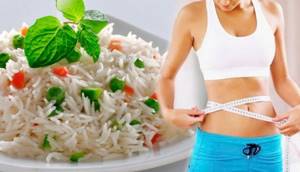
Let's look at the stages of preliminary preparation for cleansing the body with rice at home:
- Fill 3 kg of clean oblong rice with 10 liters of purified water;
- The next day, change the water and wash the rice thoroughly;
- We continue the above procedure for another 4 days. Until the liquid drained from the cereal is clear;
- Drain the water and dry the rice on the tablecloth. Then we pour it into a paper bag for storage.
And here, in fact, is the cleaning procedure itself. Every morning we cook porridge from one large spoon of prepared cereal and eat it. You need to cook without herbs, oil and spices. We continue to cleanse the body until the rice runs out.
For those who are afraid of gaining weight, let us say right away that the calorie content of boiled rice in water described above will not allow this to happen. But rice boiled with butter is sad because of its calorie content, so we don’t use auxiliary products.
How many carbohydrates are in rice. White rice
Rice is a cereal plant, annual and perennial, and its grains. White rice grains are considered to be rice grains that have undergone a full cycle of cleaning and polishing, without the bran shell. White rice is distinguished by a flat and smooth surface, most often shiny, rich white color and is divided by size into short grain, medium grain and long grain.
Rice is one of the most ancient plants consumed by humans. In regions where rice is traditionally cultivated on plantations - tropical and subtropical regions of Asia, Africa and America, rice is equated to bread in terms of prevalence and frequency of consumption (calorizator). White rice is the fastest to cook, but the least healthy when compared to brown rice.
Calories in white rice
The calorie content of white rice is 344 kcal per 100 grams of product (meaning dry rice).
Composition and beneficial properties of white rice
White rice contains complex carbohydrates necessary to maintain energy balance, fiber, which normalizes the activity of the gastrointestinal tract and is a preventative against constipation. White rice contains: B vitamins (choline, B1, B2, B5, B6), E, H and PP, as well as minerals needed by the body: potassium, calcium, magnesium, zinc, selenium, copper and manganese, iron, phosphorus and sodium. Rice removes fluid well from the human body and helps cleanse the kidneys and liver. White rice is useful for strengthening the body's defenses, as it increases immunity and has a beneficial effect on the functioning of the nervous and cardiovascular systems. Due to the presence of potassium, white rice significantly improves the salt balance, removing excess salts and serves as a protectant against salt deposits.
White rice varieties
Almost any type of rice can be turned white by removing the bran shell and polishing the grains. The most common type of white rice in our latitudes is Krasnodar round grain, but there are also Italian, Thai and other varieties of white rice. White rice is also used to prepare pilaf, but it must undergo special processing so as not to turn into porridge.

Harm of white rice
Excessive consumption of white rice, especially in combination with milk and sugar, can cause constipation and dehydration.
White rice for weight loss
White rice is included in the menu of fasting days (thanks to the ability of rice to remove fluid, you can lose up to half a kilogram per day) and several diets. Show business stars especially like to use white rice; the diets of Christina Aguilera, Dana Borisova, Kristina Orbakaite and Christina Ricci contain white rice.
White rice in cooking
White rice is an ideal product in the kitchen - it cooks quickly, is suitable for many dishes and has a wonderful taste and rich aroma. White rice is used to make simple side dishes, milk porridges and soups; it goes well with mushrooms, cottage cheese, vegetables and dried fruits. White rice is included in the fillings for pies and pancakes, it is used to prepare casseroles, cutlets and soufflés, and is used for national dishes and desserts.
You can learn more about rice and its types, about which rice is suitable for pilaf or for milk porridge or as a side dish. Copying this article in whole or in part is prohibited.

